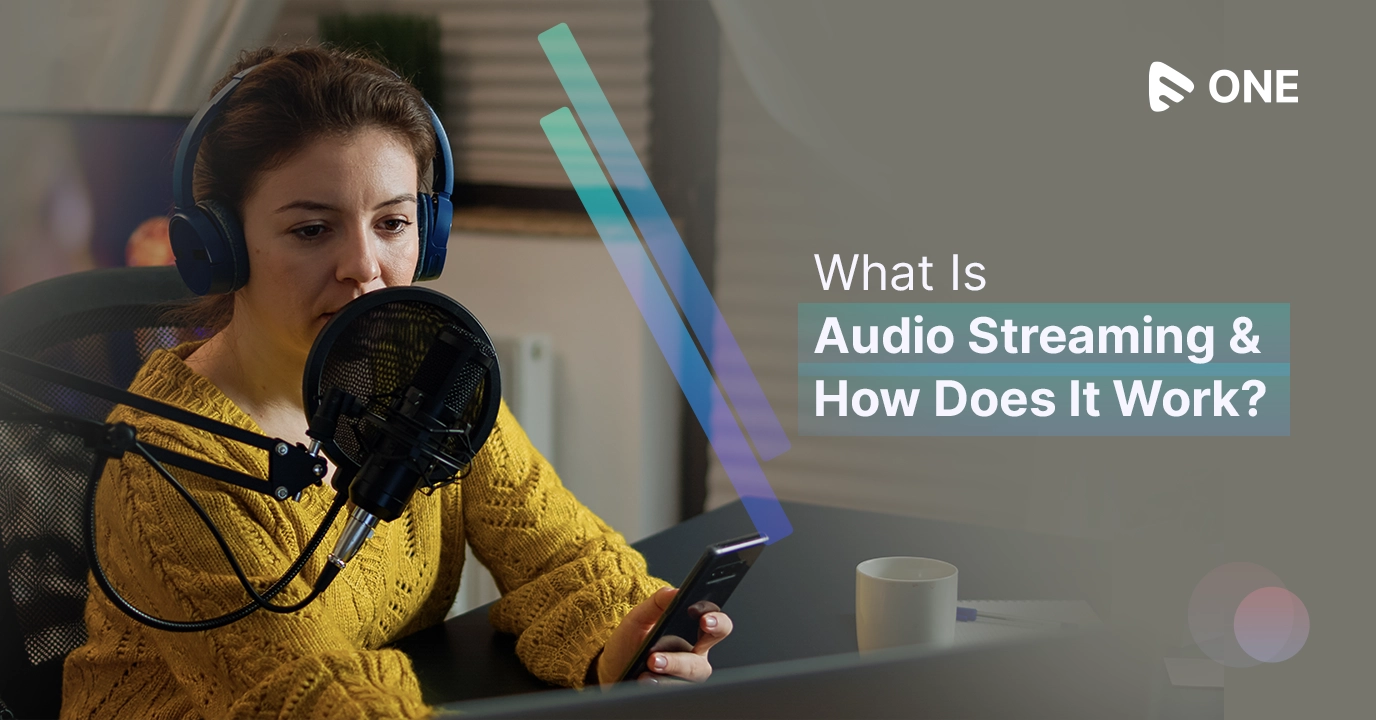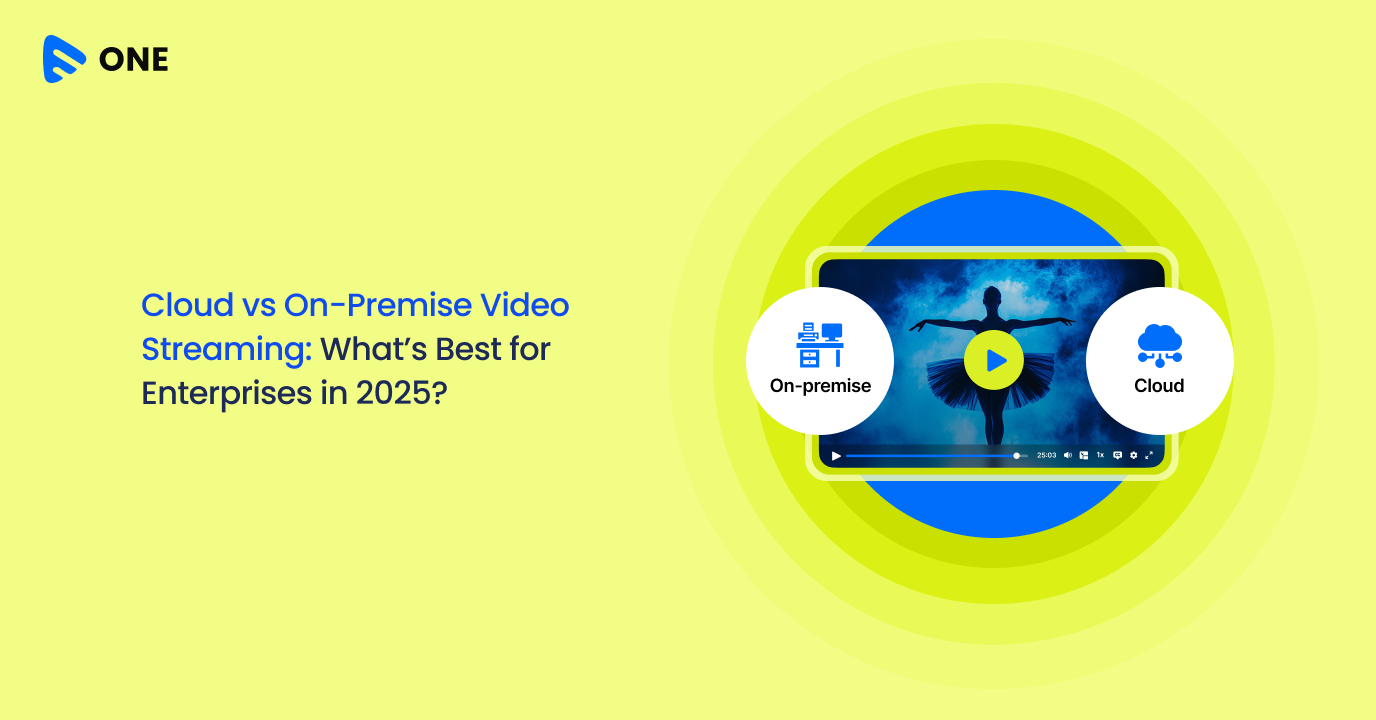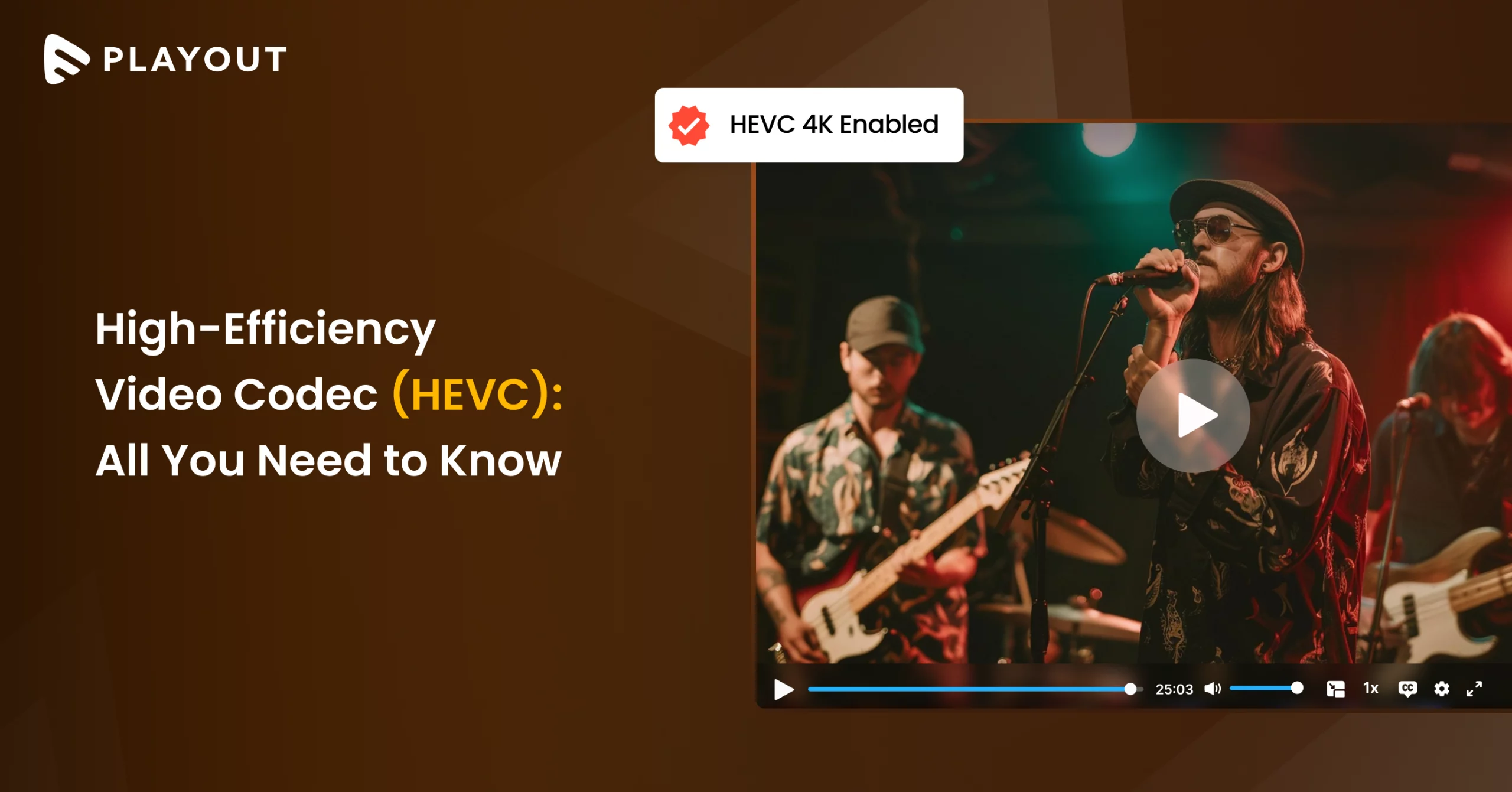Listening to your favorite music or podcast is only possible due to audio streaming technology. With audio streaming, users can listen to their favorite audio content on demand, which is more convenient than traditional radio broadcasting. Users can pause, rewind, and fast-forward audio content, and they can access it from any device with an internet connection.
Users can access a diverse range of audio content through various monetization models as well as listen to audio content in different languages, genres, and formats.
The audio streaming industry is becoming increasingly competitive, with new entrants such as Amazon Music, Tidal, and Deezer, competing with established players like Spotify and Apple Music. The audio streaming industry is likely to forge partnerships with other industries such as fitness, healthcare, and transportation to offer new experiences and benefits to users.
If you are planning to start your audio streaming service, it’s the perfect time. Muvi One can help you launch your both audio and video streaming business instantly with a bucket full of features. You can offer both music streaming and live audio broadcast to your targeted audience and earn huge profits through various monetization models.
Before getting started let’s find out what audio streaming is and how it works…

What is Audio Streaming?
Audio streaming is the process of transmitting audio contents in real-time through a network connection allowing the audience to play immediately.
This allows users to listen to music, podcasts, or other audio content without having to store the files on their devices.
Audio streaming can be either live or on-demand. In live streaming, audio is transmitted in real-time as it is being produced, such as during a radio broadcast or a live concert.
On the other hand, in on-demand streaming, audio is pre-recorded and made available for users to access whenever they want. Some examples of on-demand audio streaming services include Spotify, Apple Music, and Pandora.
Why should you start an audio streaming service?
The demand for audio streaming services has been increasing rapidly in recent years, and this trend is expected to continue in the future. With the rise of smartphones and other mobile devices, people now have more access to music and audio content than ever before. This presents a significant opportunity for entrepreneurs looking to enter the market.
Audio streaming services are not limited to music alone. There is a growing market for podcasts, audiobooks, and other audio content that can be easily distributed through a streaming service. This allows you to diversify your content offerings and attract a wider range of customers.
Monetizing your audio content can be highly profitable and allows you to build a stable, recurring revenue stream that can support ongoing growth and development.
How does Audio Streaming work?
Audio streaming works by breaking down the audio file into small data packets that can be transmitted over the internet. Here are the basic steps involved in audio streaming:
Encoding: The audio file is first encoded into a format that is suitable for streaming, such as MP3, AAC, or Ogg Vorbis. This is done using a software encoder, which compresses the audio file and converts it into a streaming format.
Streaming Server: The encoded audio file is then stored on a streaming server. The server is responsible for sending the audio data to the listener’s device.
Streaming Protocol: The streaming server uses a streaming protocol, such as HTTP Live Streaming (HLS), Dynamic Adaptive Streaming over HTTP (DASH), or Real-Time Messaging Protocol (RTMP), to transmit the audio data over the internet. The protocol breaks the audio data into small data packets, which are sent to the listener’s device in real-time.
Streaming Software: The listener’s device uses streaming software, such as a web browser or a dedicated streaming app, to connect to the streaming server and receive the audio data. The software decodes the audio data and plays it back on the listener’s device.
Decoding: The listener’s device receives the audio data packets and decodes them back into an audio format that can be played back. The audio is played back in real-time, allowing the listener to hear the audio content without having to download the entire file first.
How is Audio Streaming Shaping the music industry?
Audio streaming has had a significant impact on the music industry, shaping the way music is consumed, marketed, and distributed.
- Audio streaming has completely transformed the way musicians earn money.
- Streaming platforms pay artists based on the number of streams their songs receive, rather than traditional album sales.
- It is easier for independent artists to gain recognition and earn money from their music.
- Streaming helps reach a global audience without the need for traditional distribution channels.
- Independent artists can now distribute their music globally through streaming services, allowing them to connect with fans in countries they may have never been able to reach before. Moreover, with the advancement of technology, artists can utilize various tools and software to enhance their workflow and reach a broader audience. For instance, by leveraging cutting-edge AI-driven solutions, artists can easily convert audio to text, making it simpler to transcribe lyrics, create subtitles for music videos, or even generate written content for promotional purposes.
Audio streaming has changed the way people listen to music. Instead of buying albums or singles, people can now listen to a virtually unlimited amount of music for a fixed monthly fee. This has created a culture of music discovery, where listeners can explore new artists and genres without committing to a full purchase.
Audio streaming has driven significant innovation in audio technology. Streaming services use advanced algorithms to deliver personalized recommendations and high-quality audio to listeners. This has led to a renewed focus on audio quality and has spurred innovation in audio hardware and software.
Audio streaming platform – How can you use it?
Music streaming
Music streaming has become the dominant form of music consumption in recent years, surpassing traditional album sales and digital downloads. Streaming services like Spotify, Apple Music, and Amazon Music have millions of subscribers worldwide and have disrupted the music industry, changing the way artists earn money and how music is marketed and distributed.
It has created new opportunities for independent artists to gain exposure and earn money from their music. It has also made it easier for fans to discover new music and has democratized access to music, allowing listeners to access a vast library of music from all over the world at their fingertips.
Podcast hosting and streaming
Podcast hosting and streaming have revolutionized the way audio content is created, distributed, and consumed. Podcast streaming services have created new opportunities for content creators to reach a global audience and have allowed listeners to discover and consume audio content on their own terms. They have also given rise to a new era of audio storytelling, with podcasts covering a wide range of topics, from news and politics to true crime, comedy, and more.
Audiobook streaming
Audiobook streaming refers to the process of listening to audiobooks over the internet without downloading the entire audiobook file.
Audiobook streaming has become increasingly popular in recent years as more people are turning to audiobooks to consume books while on-the-go or while engaging in other activities. Streaming services like Audible, Scribd, and Google Play Books have millions of subscribers worldwide and have disrupted the traditional audiobook industry, changing the way books are consumed and marketed.
Live streaming events
Live audio streaming events have become increasingly popular in recent years, as they offer a convenient way for people to listen to live events from anywhere in the world. They have also created new opportunities for content creators and event organizers to reach a global audience and monetize their content through sponsorships, advertising, or paid subscriptions.
Different Audio Streaming Protocols
Real-Time Messaging Protocol (RTMP)
RTMP is commonly used for live audio streaming, especially in the context of internet radio and live event broadcasts. It offers low latency, which means that the audio content is delivered to the listener with minimal delay. This is important for live broadcasts where the audio needs to be in sync with the visuals or where there is audience interaction.
One of the advantages of RTMP as an audio streaming protocol is its reliability. It uses a TCP-based transmission protocol, which means that it ensures reliable delivery of the audio packets. This is important for live broadcasts where interruptions or drops in the audio can result in a poor listener experience.
While RTMP has been widely used for live audio streaming, it has been gradually replaced by newer protocols such as HTTP Live Streaming (HLS) and Dynamic Adaptive Streaming over HTTP (DASH), which are more widely supported by modern browsers and mobile devices.
Real-Time Transport Protocol (RTP)
Serving as the backbone for ensuring high-quality voice communication in VoIP phone services, RTP is an open standard and is widely supported by many audio streaming software and hardware solutions. It is used by popular audio streaming services, including Spotify and Pandora, and is also used by video conferencing platforms like Zoom and Google Meet.
Real-Time Transport Protocol (RTP) is a streaming protocol that is designed to deliver audio and video content in real-time over the internet. It is a widely used protocol for streaming audio and video content, including live events, webinars, and teleconferencing.
HTTP Live Streaming (HLS)
HTTP Live Streaming (HLS) is a streaming protocol developed by Apple Inc. for the delivery of audio and video content over the internet. It is widely used for streaming audio and video content on the web and mobile devices.
HLS is used for audio streaming because it provides a high-quality streaming experience, with low latency and minimal buffering. It works by breaking the audio stream into small segments and transmitting them over the internet using standard HTTP protocol.
HLS is an efficient and reliable protocol for streaming high-quality audio content over the internet, and it has become an industry standard for many audio streaming services.
Dynamic Adaptive Streaming over HTTP (DASH)
Dynamic Adaptive Streaming over HTTP (DASH) is a streaming protocol designed for the delivery of audio and video content over the internet. It is an open standard developed by the Moving Picture Experts Group (MPEG) and is widely used for audio and video streaming.
DASH supports a range of audio codecs, including MP3, AAC, and Opus, which allows for high-quality audio streaming. It also supports encryption and digital rights management (DRM) to protect the content from unauthorized access or copying.
DASH is an efficient and reliable protocol for streaming high-quality audio content over the internet, and it has become an industry standard for many audio streaming services. Its flexibility and scalability make it a popular choice for broadcasters and audio streaming services who want to reach a large audience across multiple devices.
Microsoft Smooth Streaming
Microsoft Smooth Streaming is a proprietary protocol developed by Microsoft and is widely used for audio and video streaming. Smooth Streaming also supports a range of audio codecs, including MP3, AAC, and WMA, which allows for high-quality audio streaming. It also supports encryption and digital rights management (DRM) to protect the content from unauthorized access or copying.
Advantage of Smooth Streaming as an audio streaming protocol is its integration with Microsoft technologies, such as Windows Media Player and Internet Information Services (IIS). This makes it easy for broadcasters and audio streaming services to set up and manage audio streams using Microsoft technologies.
Shoutcast and Icecast are two popular software applications used for streaming audio content over the internet.
Shoutcast was created by Nullsoft, the developers behind the popular media player Winamp. It is a proprietary software application that is used to stream audio content, such as radio broadcasts, over the internet. Shoutcast is known for its simplicity and ease of use, making it a popular choice for small to medium-sized radio stations and podcasters.
Icecast, on the other hand, is an open-source alternative to Shoutcast. It was developed as a response to the proprietary nature of Shoutcast and aims to provide users with an open and customizable platform for streaming audio content.
Equipment required for live audio streaming
A PC serves as the central hub for recording and streaming audio. It’s important to have a powerful enough computer that can handle the demands of audio processing and streaming.
There are several types of microphones available, but for live audio streaming, a dynamic or condenser microphone is typically the best option. Dynamic microphones are more rugged and durable, while condenser microphones offer higher sound quality. You’ll also want to consider the polar pattern of the microphone, which refers to its sensitivity to sound from different directions.
Audio interface connects your microphone to your computer and allows you to control the audio levels and quality. Audio interfaces come in various shapes and sizes, but they all serve the same basic function of converting analog audio signals into digital data that can be processed by your computer.
Audio recording and streaming software
To record and stream audio, you’ll need audio recording and streaming software. There are many different programs available, both free and paid, that can handle this task. They allow you to record and edit audio, apply effects and filters, and stream your audio in real-time.
Headphones help you monitor the audio quality and make any necessary adjustments on the fly. It’s important to choose headphones that are comfortable to wear for extended periods and provide accurate sound reproduction.
Optional equipment (pop filter, mic stand, soundproofing kit)
Lastly, there are some optional equipment that can improve the quality of your live audio stream. A pop filter, for example, can help reduce plosive sounds (such as “p” and “b” sounds) and improve clarity. A mic stand can help position your microphone correctly, and a soundproofing kit can help reduce unwanted background noise.
Examples of Audio Streaming Services
Spotify is an audio streaming platform that has become incredibly popular in recent years. Spotify has over 365 million monthly active users, including 165 million premium subscribers who pay a monthly fee to access premium features. The platform offers both free and paid subscription options, with the free version containing ads and certain limitations.
Apple Music is a popular audio streaming platform that allows users to listen to a vast collection of music from various genres and artists. The platform was launched in 2015 by Apple Inc.
The platform offers a range of curated playlists, personalized recommendations, and radio stations based on the user’s listening habits. Apple Music also provides exclusive content such as original shows, documentaries, and live events.
Amazon Music is a popular audio streaming service that allows users to access millions of songs and albums from various genres and artists. The platform was launched in 2007 by Amazon and is available on a range of devices, including iOS and Android smartphones, tablets, computers, smart TVs, and smart speakers.
Amazon Music also includes a feature called “Alexa,” which allows users to control their music playback with voice commands. Alexa is Amazon’s virtual assistant, and it can be integrated into various devices, such as the Amazon Echo and Fire TV Stick, allowing users to play music hands-free.
SoundCloud is an audio streaming platform that allows users to upload, share, and discover music, podcasts, and other audio content. The platform was launched in 2008 by Alexander Ljung and Eric Wahlforss and has since become a popular destination for independent artists and music enthusiasts.
The platform’s focus on user-generated content and community-driven features has made it a popular choice among music enthusiasts and up-and-coming artists.
Stitcher is a podcast streaming and hosting platform that allows users to listen to and discover new podcasts. It was founded in 2008 by Noah Shanok and Peter deVroede and was acquired by the E.W. Scripps Company in 2016.
Stitcher provides a wide variety of podcast genres including news, politics, entertainment, sports, and true crime. Users can browse and search for podcasts, create custom playlists, and receive personalized recommendations based on their listening habits.
Podbean is a podcast hosting platform that was founded in 2006. It provides a range of tools and services to help podcasters create, host, and promote their podcasts.
Podbean allows podcasters to upload their audio content and distribute it to various podcast platforms, including Apple Podcasts, Google Podcasts, and Spotify. It also provides a customizable website for podcasters, where they can showcase their podcast, engage with their listeners, and monetize their content.
iHeartRadio is a free online audio streaming service that provides access to live radio stations, podcasts, and curated music playlists. It was launched in 2008 by Clear Channel Communications, which was later renamed iHeartMedia.
iHeartRadio offers live streaming of over 850 radio stations across the United States, as well as custom radio stations based on specific genres or artists. It also provides access to a large selection of podcasts, including many popular shows such as The Joe Rogan Experience, Serial, and Stuff You Should Know.
Launch your Own Audio Streaming Service Like Spotify with Muvi One!
Muvi One – world’s only all-in-one no code platform helps you launch your own audio as well as video streaming platform offering music streaming, video streaming and live audio and video broadcast to your audience.
Muvi One comes with advanced features such as:
- Video encoding and transcoding at multiple bitrates
- HTML5 video player
- Multi CDN
- Adaptive online video player
- Video security features like multi-DRM, watermarking, screen record protection and IP restrictions among others
- Cross-browser and cross-device video playback capability
- Fully customizable website with ready to plug/use templates and an advanced functionality of a customizable visual designer for the no-coding DIYers.
- An advanced CMS
- Multiple social media channel integration
- Video API
- Multiple monetization models
- Integration with most-popular payment gateways like Paypal, Stripe, PayU, Authorize.net, etc
- Full video API integration
- SDKs for iOS and Android developer
Launch your end-to-end audio streaming solution like Spotify instantly and monetize your streams from the day one using various monetization models. Take a free trial to explore super-cool features of Muvi One now!
FAQs:
Can I integrate Muvi with my existing website or mobile app for audio streaming?
Yes, you can integrate Muvi with your existing website or mobile app for audio streaming. Muvi provides an API-driven platform that enables you to easily integrate your website or mobile app with Muvi’s audio streaming capabilities.
What are the differences between audio streaming and podcasting?
Audio streaming and podcasting are two different methods of delivering audio content to listeners. Audio streaming delivers content in real-time, allowing listeners to hear the audio as it is being streamed. Podcasting, on the other hand, is pre-recorded audio content that can be downloaded or streamed on-demand.
Audio streaming typically refers to live broadcasts, music streaming, or radio shows, while podcasting typically refers to pre-recorded episodes on a specific topic or series.
What are the features of Muvi that make it suitable for audio streaming?
Muvi is a comprehensive video and audio streaming platform that offers a range of features that make it suitable for audio streaming. Some key features of Muvi that makes it a good choice for audio streaming are:
- Live Streaming
- On-demand Streaming
- Customizable Player Design
- Monetization Options
- Multi-Platform Support
- Analytics and Reporting
What are the advantages of audio streaming?
Audio streaming offers a convenient way for listeners to access a wide range of audio content without the need to download or store files on their devices.
With live streaming, audio content can be broadcasted and accessed in real-time, which allows broadcasters to deliver up-to-date news, sports events, and live performances to listeners as they happen.
Audio streaming can be accessed on a wide range of devices, including smartphones, tablets, laptops, smart speakers, and smart TVs, which makes it easy for listeners to access content from any location. Audio streaming services can offer monetization options for broadcasters, such as subscription-based models, advertising, or pay-per-view, which can generate revenue for the broadcaster while providing access to quality content for listeners.
How is audio streaming technology evolving?
Audio streaming technology is constantly evolving to improve the listening experience for consumers and offer new opportunities for broadcasters. Some of the key ways that audio streaming technology is evolving:
- Improved Audio Quality
- Voice-Activated Devices
- Voice-Activated Devices
- Multi-Device Support
- Interactive Content


















Add your comment